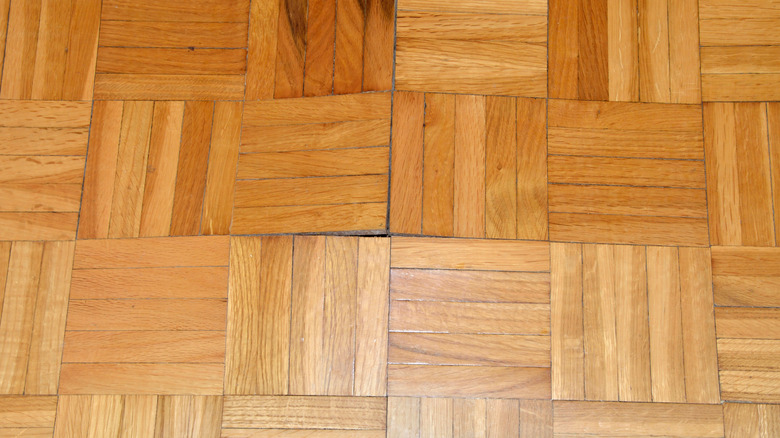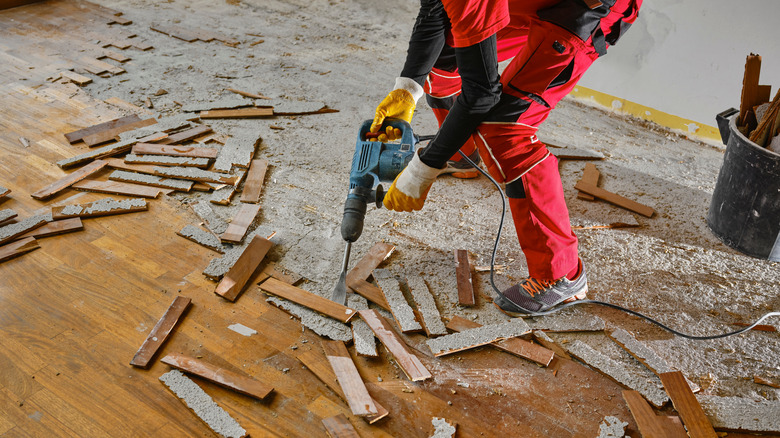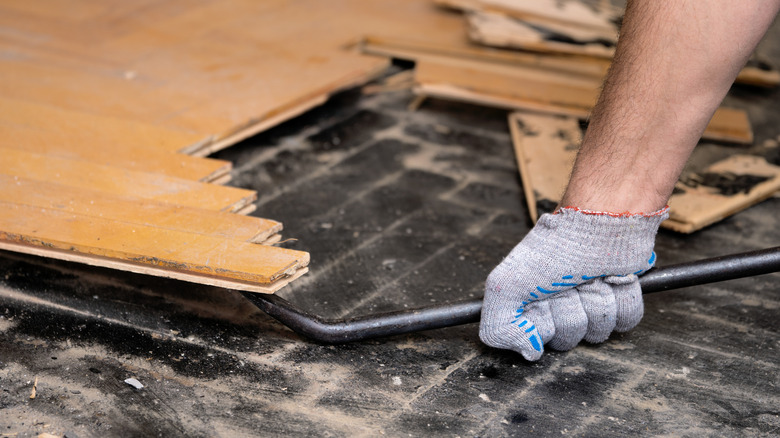Our Expert's Tips For Fixing Buckled Hardwood Floors
Hardwood floors are a timeless choice preferred by many homeowners, but there's a lot that can go wrong after they're installed. The material is susceptible to all sorts of damage that can take away from its visual appeal. Buckling is one of them. If you've run into this issue, fear not, because our expert shared a few tips for fixing hardwood floors that are damaged by buckling. Brett Miller, Vice President of Technical Education & Certification at the National Wood Flooring Association (NWFA), explained you must replace the buckled suctions of flooring, have a professional assess the damage, and resolve any moisture issues that may have caused the buckling.
The expert also provided information on what exactly causes hardwood floors to buckle in the first place. "A buckled floor is one that has separated, or lifted from the subfloor," he shared while speaking exclusively to House Digest. "Buckled wood floors are most commonly caused by excessive moisture — either in the air, subfloor, or flooding." Since buckled floors may signal water damage, it's vital that you take the problem seriously and work to resolve it as soon as possible. Thankfully, Miller's advice should make the process a lot easier.
Resolve water damage, call a professional, and avoid common mistakes
While speaking exclusively to House Digest, Brett Miller shared that your first step should be to handle any water damage on your wood floors. "If there has been a water leak or flood, remove the source of the water immediately and dry up the site of the water damage," he explained. The expert also revealed that any flooring that has separated from the subfloor needs to be replaced.
"Before reinstalling any new flooring in the affected area, the moisture condition needs to be addressed," he added. "You can try to fix the moisture conditions in the home by using a dehumidifier to help the floor and subfloor dry to normal levels." Miller's next tip is to bring in a professional to assess the extent of the damage. "If caught early, spot repair/replacement may be possible. In other cases, complete replacement is necessary," he shared.
The expert also revealed some common mistakes you need to avoid. First, you shouldn't just reattach the buckled boards back to the subfloor underneath them. "Once a floor and subfloor have become wet, and the fastening mechanism for the flooring has become dislodged, it will no longer perform as it once had," Miller explained. This is why you need to remove the buckled flooring completely. Another mistake some make is adding the floor replacement before the subfloor is able to dry completely. Miller again stressed the importance of calling on a professional rather than attempting to fix the damage on your own.
How to know whether you can fix a moisture-damaged floor
There are some circumstances in which a damaged floor can be fixed rather than entirely replaced. "If a wood floor gets damaged and cups, it is possible that it may dry back out and not need to be replaced," Brett Miller explained while speaking exclusively to House Digest. "A cupped floor is a concave or dished appearance of individual boards with the edges of the boards raised higher than the center." When water leaks under real wood floors, you can often repair the material. However, Miller shared, "once the flooring has buckled, the fasteners or adhesives are no longer effective, and the installation system will never return to its original state."
It's also important to understand how to prevent your floors from buckling in the first place. According to the expert, you can do this by tackling standing water problems and leaks as soon as possible. And consider having floors professionally installed since DIY wood flooring installation may make them more susceptible to damage. "The most important step you can take to prevent buckling is to use an NWFA Certified Wood Flooring Professional to do your installation in the first place," he shared. "NWFA members have access to industry standards, training programs, and skills certifications that validate their professional expertise." These professionals will conduct the proper humidity, temperature, and moisture testing.


